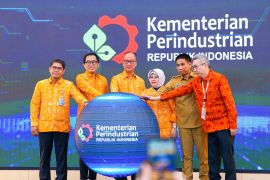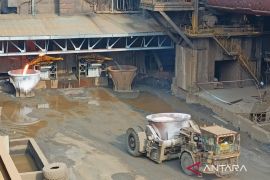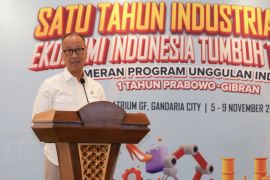"One of our efforts to accelerate the NZE target is by minimizing industrial waste and Industrial Process and Product Use (IPPU) components in industries," Industry Ministry Agus Gumiwang Kartasasmita noted in a statement received on Friday.
The ministry remarked that currently, the industrial sector contributes around 15-20 percent of the total national greenhouse gas emissions. Hence, the ministry is focused on implementing a decarbonization strategy in the industrial sector by embracing relevant stakeholders.
According to Kartasasmita, greenhouse gas emissions from the industrial sector consist of energy use, with 60 percent; 25 percent from industrial waste; and 15 percent from IPPU.
The minister stated that emissions from energy use will continue to be reduced by increasing synergy with other ministries and institutions as well as stakeholders, who play an important role in providing clean energy sources.
This is because several industrial sub-sectors, such as transportation equipment, have quite high life cycle emissions. Life cycle emissions resume the total amount of greenhouse gases and particles emitted during a vehicle's life cycle from production, to use, and disposal.
For comparison, based on the 2021 Polestar and Rivian study in Europe, North America, and Asia Pacific reported in the Polestar and Rivian Pathway Report (2023), during their life cycle, the emissions produced by electric vehicles are lower, namely 39 tons of carbon dioxide equivalent (tCO2e), compared to hybrid electric vehicles (HEV) of 47 tCO2e, and conventional or internal combustion engine (ICE) vehicles that reached 55 tCO2e, Kartasasmita remarked.
The high life cycle emissions of conventional vehicles and hybrid electric vehicles mainly come from exhaust gas emissions during use (tailpipe emissions), amounting to 32 tCO2e (57 percent) and 24 tCO2e (51 percent), respectively.
Meanwhile, in electric vehicles, the production factor of electrical energy is the main factor producing emissions, namely 26 tCO2e (66.7 percent).
The minister said that the carbon footprint is also found in the production of batteries for battery electric vehicles (BEV) and hybrid electric vehicles, respectively at 5 tCO2e and 1 tCO2e. Production of batteries and other components requires significant mining minerals and energy. However, innovation and improvements in the battery supply chain and packaging technology have now developed to reduce this impact.
However, during use, electric vehicles do not produce exhaust emissions because they use electric motors and batteries as propulsion. Meanwhile, conventional vehicles produce direct emissions from the fuel combustion process depending on the type and quality of fuel used, for example, gasoline or diesel, and engine efficiency, he noted.
It is still important to note that the impact of emissions during a vehicle's life cycle is greatly influenced by the electrical energy source used. Electric vehicles will produce lower emissions if the electrical energy used for the production process and during battery charging comes from clean and environmentally friendly energy, he revealed.
"We hope that decarbonization of the electricity sector can help reduce the emission phase in BEVs," the minister remarked.
He noted that in general, the decarbonization strategy in the industrial sector consists of the use of energy-saving and low-emission technology; use of new and renewable energy (EBT); energy, water, and raw material efficiency; as well as waste management and a circular economy.
"We also encourage the industrial sector to be more proactive to achieve the NZE target in the industrial sector in 2050, or 10 years earlier than the national NZE target in 2060," he emphasized.
Related news: Prioritizing 9 industrial subsectors for decarbonization: minister
Related news: Carbon tax to give businesses alternative to reduce emissions: MoF
Related news: Indonesia pursues GHG emission reduction of 358 million tons in 2030
Translator: Ade Irma J, Resinta Sulistiyandari
Editor: Azis Kurmala
Copyright © ANTARA 2023












